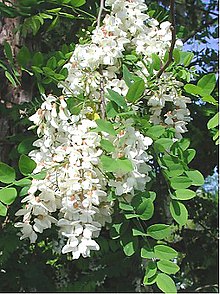| Robinia | |
|---|---|

| |
| Robinia pseudoacacia | |
| Scientific classification | |
| Kingdom: | Plantae |
| Clade: | Tracheophytes |
| Clade: | Angiosperms |
| Clade: | Eudicots |
| Clade: | Rosids |
| Order: | Fabales |
| Family: | Fabaceae |
| Subfamily: | Faboideae |
| Tribe: | Robinieae |
| Genus: | Robinia L. (1753) |
| Species[1] | |
|
4; see text | |
| Synonyms[1] | |
| |
Robinia is a genus of flowering plants in the family Fabaceae, tribe Robinieae, native to North America. Commonly known as locusts,[2] they are deciduous trees and shrubs growing 4–25 metres (13–82 ft) tall. The leaves are pinnate with 7–21 oval leaflets. The flowers are white or pink, in usually pendulous racemes. Many species have thorny shoots, and several have sticky hairs on the shoots.
The genus is named after the royal French gardeners Jean Robin and his son Vespasien Robin, who introduced the plant to Europe in 1601.
The number of species is disputed between different authorities, with as few as four recognised by some authors,[3][1] while others recognise up to 10 species. Several natural hybrids are also known.[1]
Some species of Robinia are used as food by caterpillars of Lepidoptera, including such moths as the brown-tail (Euproctis chrysorrhoea), the buff-tip (Phalera bucephala), the engrailed (Ectropis crepuscularia), the giant leopard moth (Hypercompe scribonia), the locust underwing (Euparthenos nubilis), and Gracillariidae leaf miners like Chrysaster ostensackenella, Macrosaccus robiniella and Parectopa robiniella.
- ^ a b c d Robinia L. Plants of the World Online. Retrieved 19 September 2023.
- ^ USDA, NRCS (n.d.). "Robinia". The PLANTS Database (plants.usda.gov). Greensboro, North Carolina: National Plant Data Team. Retrieved 22 October 2015.
- ^ "Robinia". LegumeWeb. International Legume Database & Information Service.